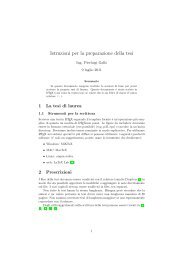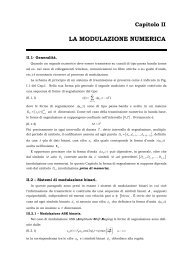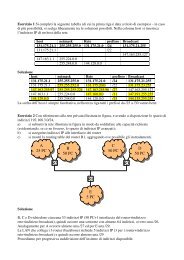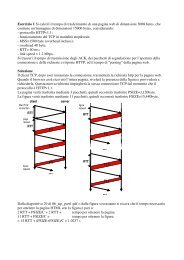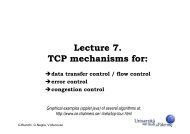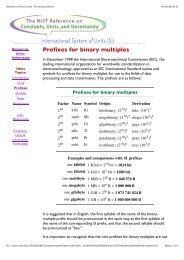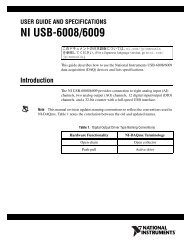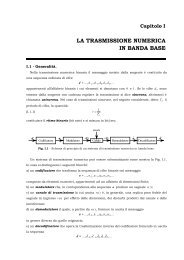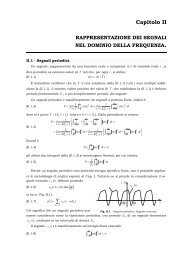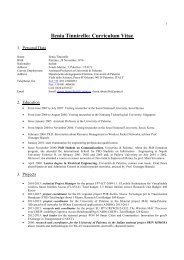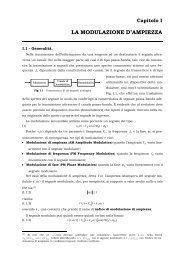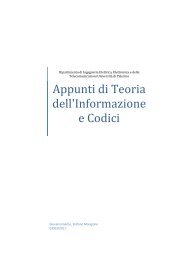Ilenia Tinnirello
Ilenia Tinnirello
Ilenia Tinnirello
Create successful ePaper yourself
Turn your PDF publications into a flip-book with our unique Google optimized e-Paper software.
wireless networks<br />
<strong>Ilenia</strong> <strong>Tinnirello</strong><br />
<strong>Ilenia</strong>.tinnirello@tti.unipa.it<br />
Giuseppe Bianchi, <strong>Ilenia</strong> <strong>Tinnirello</strong>
Reti Radiomobili<br />
Struttura corso<br />
A: Pianificazione di sistemi cellulari<br />
» Richiami propagazione/attenuazione; Ingegneria del traffico (Erlang)<br />
» Applicazioni alle reti cellulari<br />
(verificare cosa e’ noto e cosa no :-)<br />
B: GSM / WiFi<br />
» Interfaccia radio<br />
» Protocolli<br />
» Infrastrutture di rete e reti ad hoc<br />
C: Tecnologie in evoluzione: UMTS/ LTE / IMS / WiMax<br />
» … in aumento/evoluzione<br />
» letteratura scientifica del settore<br />
Giuseppe Bianchi, <strong>Ilenia</strong> <strong>Tinnirello</strong>
Supporti didattici<br />
Forum<br />
Per Q/A, discussioni, informazioni<br />
Puntatori interessanti da studenti<br />
Lucidi lezioni<br />
Su web<br />
Testi Testi<br />
2 capitoli libro Shankar per parte A<br />
Testo monografico per GSM, WLAN, WiMax, UMTS<br />
Articoli scientifici<br />
Lucidi + testi lingua inglese<br />
(qualche piccolo problema riscontrato)<br />
Giuseppe Bianchi, <strong>Ilenia</strong> <strong>Tinnirello</strong>
Testi<br />
(fotocopie disponibili)<br />
-Shankar, “Introduction to Wireless Systems”, (cap. 2<br />
e 4), Wiley, 2001<br />
-Stallings, “Wireless Communications and Networks”,<br />
Prentice Hall, 2001<br />
(versioni elettroniche disponibili)<br />
-Eberspacher, Vogel, Bettstetter, “GSM switching,<br />
services & protocols”, Wiley, 2001<br />
-Matthew Gast, “802.11 Wireless Networks: The<br />
Definitive Guide”, O'Reilly<br />
-Jeffreey G. Andrews, et al. “Fundamentals of<br />
WiMax”, Prentice Hall<br />
-Mikka Poikselka, “The IMS IP multimedia concepts<br />
and services in the mobile domain”<br />
Giuseppe Bianchi, <strong>Ilenia</strong> <strong>Tinnirello</strong>
Modalità esame (fino all’anno scorso..)<br />
A+B o C+orale<br />
Prova A “quantitativa”<br />
Pianificazione di sistemi cellulari<br />
Esercizi scritti (3)<br />
Prova B su parte monografica<br />
su su GSM/WLAN<br />
7/8 domande scritte e/o prova orale<br />
Prova C su approfondimenti<br />
2 esercizi su modelli e simulatore e 3 domande scritte<br />
Prova orale su articolo scientifico<br />
Giuseppe Bianchi, <strong>Ilenia</strong> <strong>Tinnirello</strong>
Modalità esame nuova<br />
Unica prova scritta con:<br />
3 esercizi su pianificazione di sistemi cellulare e/o modelli di<br />
protocolli<br />
7 domande su GSM/WLAN/WiMax/UMTS approfondimenti<br />
(volete mantenere le due prove separate??)<br />
Prova orale su articolo scientifico<br />
selezionato dalla letteratura del<br />
settore (da concordare con il<br />
docente a fine corso)<br />
Giuseppe Bianchi, <strong>Ilenia</strong> <strong>Tinnirello</strong>
History<br />
Lecture 0<br />
Giuseppe Bianchi, <strong>Ilenia</strong> <strong>Tinnirello</strong>
Wireless communication<br />
Early wireless communication:<br />
in the 400-900 TeraHertz Band!<br />
150 BC smoke signals (Greece)<br />
1794, optical telegraph, Claude Chappe<br />
What is wireless communication:<br />
Any form of communication that does not require the<br />
transmitter and receiver to be in physical contact<br />
Electromagnetic wave propagated through free-space<br />
Radar, RF, Microwave, IR, Optical<br />
Giuseppe Bianchi, <strong>Ilenia</strong> <strong>Tinnirello</strong>
types of communication<br />
Simplex<br />
one-way communication<br />
radio, TV, etc<br />
Half-duplex:<br />
two-way two-way communication but not simultaneous<br />
push-to-talk radios, etc<br />
Full-duplex:<br />
two-way communication<br />
cellular phones<br />
Frequency-division duplex (FDD)<br />
Time-division duplex (TDD): simulated full-duplex<br />
Giuseppe Bianchi, <strong>Ilenia</strong> <strong>Tinnirello</strong>
Why wireless communication?<br />
User Mobility<br />
Reduced Cost (cheap infrastructure)<br />
Cabling very critical<br />
Developing nations utilize cellular telephony rather than<br />
laying twisted-pair wires to each home<br />
Flexibility<br />
Can easily set-up temporary LANs<br />
Disaster situations<br />
Office moves<br />
Only use resources when sending or<br />
receiving a signal<br />
Giuseppe Bianchi, <strong>Ilenia</strong> <strong>Tinnirello</strong>
Why wireless different than<br />
wired?<br />
Noisy, time-varying channel<br />
BER varies by orders of magnitude<br />
Environmental conditions affect transmission<br />
Shared medium<br />
Other users create interference<br />
Must develop ways to share the channel<br />
Bandwidth is limited<br />
spectrum allocated by state rules<br />
ISM band for unlicensed use<br />
Giuseppe Bianchi, <strong>Ilenia</strong> <strong>Tinnirello</strong>
History of wireless<br />
communication<br />
1896: Marconi<br />
first demonstration of wireless telegraphy<br />
tx of radio waves to a ship at sea 29 km away<br />
long wave transmission, high power req. (200 kW and +)<br />
1901: Marconi<br />
Telegraph across the atlantic ocean<br />
Close to 3000 Km hop!<br />
1907 Commercial transatlantic connections<br />
huge ground stations (30 by100m antennas)<br />
1915: Wireless telephony established<br />
NY – S. Francisco<br />
Virginia and Paris<br />
1920 Marconi:<br />
Discovery of short waves (< 100m)<br />
reflection at the ionosphere<br />
(cheaper) smaller sender and receiver, possible due to the invention of the<br />
vacuum tube (1906, Lee DeForest and Robert von Lieben)<br />
Giuseppe Bianchi, <strong>Ilenia</strong> <strong>Tinnirello</strong>
History of wireless<br />
communication<br />
1920's: Radio broadcasting became popular<br />
1928: many TV broadcast trials<br />
1930's: TV broadcasting deployment<br />
1946: First public mobile telephone service in US<br />
St. Louis, Missouri<br />
Single cell system<br />
1960's: Bell Labs developed cellular concept<br />
brought mobile telephony to masses<br />
1960’s: Communications satellites launched<br />
Late 1970's: technology advances enable<br />
affordable cellular telephony<br />
entering the modern cellular era<br />
1974-1978: First field Trial for Cellular System<br />
AMPS, Chicago<br />
Giuseppe Bianchi, <strong>Ilenia</strong> <strong>Tinnirello</strong>
1st generation mobile systems<br />
First generation: 1980’s<br />
Several competing standards in<br />
different countries<br />
NMT (Nordic Mobile Telephone)<br />
Scandinavian standard; adopted in most<br />
of Europe<br />
First First european system (Sweden, 1981)<br />
TACS (Total Access Communication<br />
Systems), starts in 1985<br />
UK standard; A few of Europe, Asia,<br />
Japan<br />
AMPS (Advanced Mobile Phone<br />
Service)<br />
US standard<br />
C-Netz (Only in Germany)<br />
Radiocom 2000 (Only in France)<br />
Giuseppe Bianchi, <strong>Ilenia</strong> <strong>Tinnirello</strong><br />
Analog transmission<br />
Frequency modulation<br />
Various bands:<br />
NMT:<br />
450 MHz first<br />
900 MHz later<br />
TACS<br />
900 MHz<br />
AMPS<br />
800 MHz<br />
Today still in use in lowtechnology<br />
countries<br />
And not yet completely<br />
dismissed in high-tech<br />
countries
2nd generation mobile systems<br />
4 systems<br />
Global System for Mobile (GSM)<br />
Digital AMPS (D-AMPS), US<br />
Code Division Multiple Access<br />
(IS-95) – Qualcomm,US<br />
Personal Personal Digital Cellular<br />
(PDC),Japan<br />
GSM by far the<br />
dominant one<br />
Originally pan-european<br />
Deployed worldwide<br />
(slow only in US)<br />
Giuseppe Bianchi, <strong>Ilenia</strong> <strong>Tinnirello</strong><br />
Basic bands:<br />
900 MHz<br />
1800 MHz<br />
(Digital Cellular System:<br />
DCS-1800)<br />
1900 1900 MHz<br />
(Personal Communication<br />
System:PCS-1900,US only)<br />
Specifications for<br />
GSM-400 (large areas)<br />
GSM-800 (north america)
Timing<br />
1982: Start of GSM-specification in<br />
Europe (1982-1990)<br />
1983: Start of American AMPS<br />
widespread deployment<br />
1984 CT-1 standard (Europe) for<br />
cordless telephones<br />
1991 1991 Specification of DECT<br />
Digital European Cordless Telephone (today: Digital<br />
Enhanced Cordless Telecommunications)<br />
- ~100-500m range, 120 duplex channels, 1.2Mbit/s data<br />
transmission, voice encryption, authentication<br />
1992: Start of GSM operation Europewide<br />
1994: DCS-1800<br />
Giuseppe Bianchi, <strong>Ilenia</strong> <strong>Tinnirello</strong>
2 ½ generation mobile systems<br />
GSM incremental extension<br />
High speed circuit switched data<br />
(HSCSD)<br />
Circuit switched data communication<br />
Uses up to 4 slots (1 slot = 9.6 or 14.4 Kbps)<br />
General Packet Radio Service (GPRS)<br />
Packet Packet data (use spectrum only when needed!)<br />
dial-up comparable speed<br />
Enhanced Data-rates for Global Evolution<br />
(EDGE)<br />
Higher data rate available on radio interface (3x)<br />
» Up to 384 Kbps (8 slots)<br />
» Thanks to new modulation scheme (8PSK)<br />
» May coexist with old GMSK<br />
Giuseppe Bianchi, <strong>Ilenia</strong> <strong>Tinnirello</strong>
3rd generation mobile systems<br />
UMTS (Universal Mobile<br />
TelecommunicationSystem)<br />
ITU standard: IMT-2000 (International Mobile<br />
Telecommunication – 2000)<br />
UMTS forum created in 1996<br />
Later Later on 3GPP forum (bears most of<br />
standardization activities)<br />
Wideband CDMA radio interface<br />
But several other proposals accepted as<br />
“compatible”<br />
Radio spectrum: 1885-2025 & 2110-2200 MHz<br />
Long Term Evolutions<br />
Giuseppe Bianchi, <strong>Ilenia</strong> <strong>Tinnirello</strong>
History of Wireless Data<br />
Early Wireless LAN proprietary products<br />
WaveLAN (AT&T) - the ancestor of 802.11<br />
HomeRF (Proxim)<br />
45% of the home network in 2000; 30% in 2001, … ε% today<br />
Abandoned by major chip makers (e.g. Intel: dismissed in april 2001)<br />
IEEE 802.11 Committee formed in 1990<br />
Charter: specification of MAC and PHY for WLAN<br />
First standard: june 1997<br />
1 1 and 2 Mbps operation<br />
Reference standard: september 1999<br />
Multiple Physical Layers<br />
2.4GHz Industrial, Scientific & Medical shared unlicensed band<br />
» Legacy; 802.11b/g<br />
5 GHz ISM (802.11a)<br />
1999: Wireless Ethernet Compatibility Alliance<br />
(WECA) certification<br />
Later on named Wi-Fi<br />
Boosted 802.11 deployment!!<br />
Giuseppe Bianchi, <strong>Ilenia</strong> <strong>Tinnirello</strong>
WLAN speeds<br />
802.11a: PHY for 5 GHz<br />
802.11b: higher rate PHY for 2.4<br />
GHz<br />
802.11g: OFDM for 2.4 GHz<br />
802.11n: ??? (Higher data rate)<br />
Launched in september 2003<br />
Minimum goal: 108 Mbps (but higher numbers<br />
considered)<br />
Giuseppe Bianchi, <strong>Ilenia</strong> <strong>Tinnirello</strong>
Why so much talking about of<br />
802.11 today?<br />
802.11: no more “just” a WLAN<br />
Hot-spots<br />
Where the user goes, the network is available: home,<br />
school, office, hotel, university, airport, convention center…<br />
Freedom to roam with seamless connectivity in every<br />
domain, with single client device<br />
May May compete (complement) with 3G for<br />
Wireless Internet access<br />
Which of these two is the<br />
proper (closer) picture<br />
of Wireless Internet and<br />
Mobile Computing?<br />
Which technology is most suited?<br />
Giuseppe Bianchi, <strong>Ilenia</strong> <strong>Tinnirello</strong>
GPRS, 3G – UMTS<br />
< 400 Kb/s Kms<br />
Mobile Broadband Internet<br />
IEEE 802.11 (b)<br />
> 10 Mb/s 100 m<br />
Bluetooth<br />
< 800 Kb/s 10 m<br />
The global picture<br />
Wide Area<br />
Local Area<br />
Personal Area<br />
Giuseppe Bianchi, <strong>Ilenia</strong> <strong>Tinnirello</strong><br />
802.11/UMTS<br />
switching<br />
BT/802.11<br />
switching<br />
PAN:<br />
collection of secure<br />
connections between<br />
devices in a<br />
“very” local area<br />
WAN:<br />
everywhere outside of<br />
the hotspots, where<br />
wireless Internet<br />
connection are<br />
provided<br />
LAN:<br />
collection of secure<br />
“hot spot”<br />
connections, providing<br />
broadband access to<br />
the Internet



